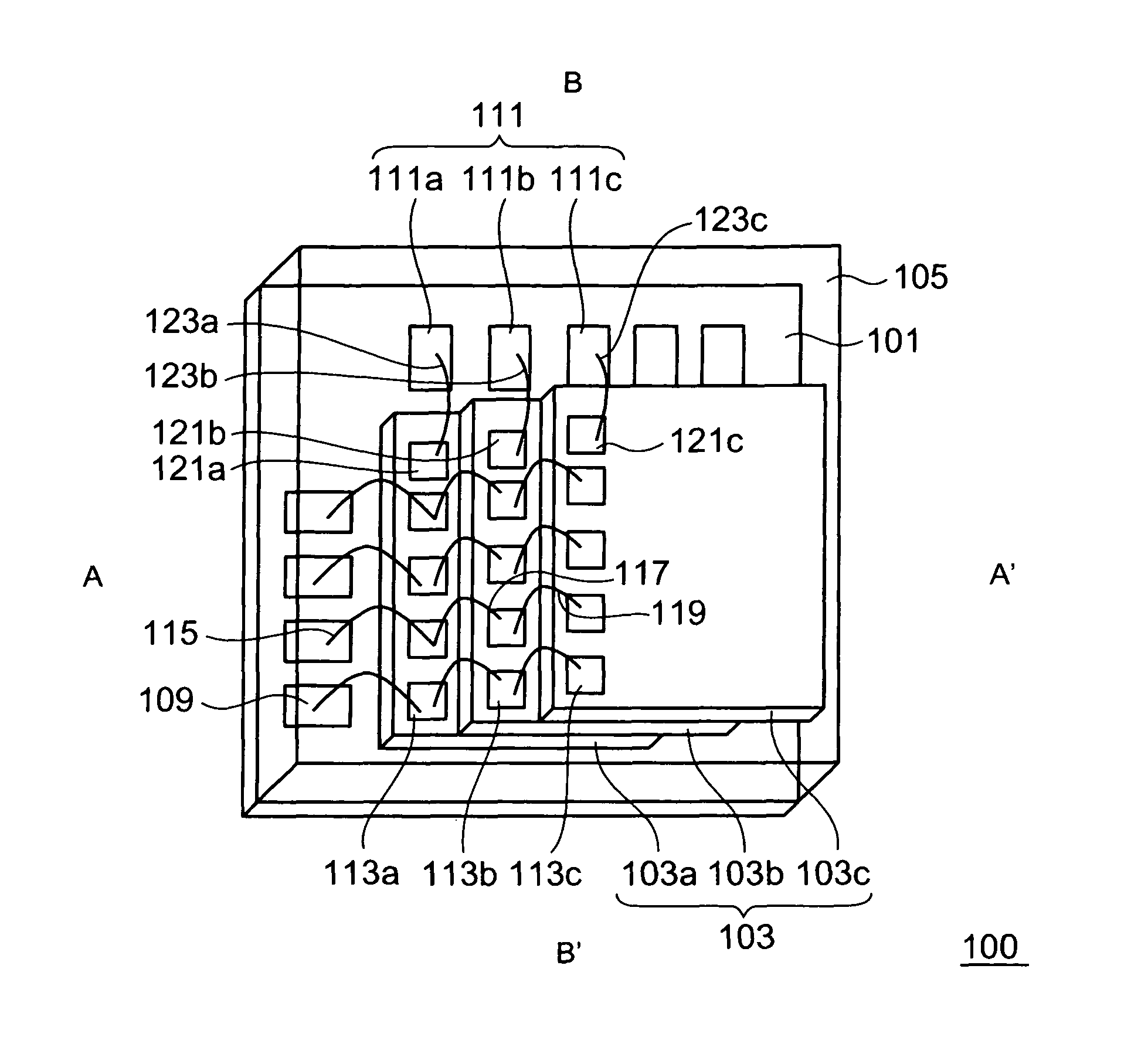Semiconductor device including mounting board with stitches and first and second semiconductor chips
a technology of semiconductor chips and mounting boards, applied in semiconductor devices, semiconductor/solid-state device details, electrical apparatus, etc., can solve the problems of complicated arrangement of bonding wires, increased package size, and increased package area, so as to suppress the increase in package size, reduce the connection distance between each chip select pad and each second stitch, and increase the package area
- Summary
- Abstract
- Description
- Claims
- Application Information
AI Technical Summary
Benefits of technology
Problems solved by technology
Method used
Image
Examples
first embodiment
[0051]FIG. 1 is a perspective view showing a structure of a semiconductor package according to a first embodiment of the present invention. FIG. 2 is a cross-sectional diagram of the semiconductor package taken along the line A-A′ of FIG. 1. FIG. 3 is a cross-sectional diagram of the semiconductor package taken along the line B-B′ of FIG. 1. FIG. 4 is a plan view showing a back surface of a semiconductor package 100 shown in FIG. 1.
[0052]As shown in FIGS. 1 to 4, a semiconductor device (semiconductor package 100) according to the first embodiment of the present invention includes a first memory chip and a second memory chip (first memory chip 103a and second memory chip 103b) mounted in the stated order from below on one surface (chip mounting surface) of a mounting board 101. The semiconductor package 100 further includes a third memory chip 103c mounted on the second memory chip 103b. Hereinafter, the first memory chip 103a, the second memory chip 103b, and the third memory chip 1...
second embodiment
[0084]FIG. 8 is a cross-sectional diagram showing a structure of a semiconductor package according to a second embodiment of the present invention. A basic structure of a semiconductor package 110 shown in FIG. 8 is similar to that of the semiconductor package 100 (see FIG. 2) according to the first embodiment of the present invention. However, the semiconductor package 110 is different from the semiconductor package 100 in that the side adjacent to the second stitches 111, that is, the side adjacent to the side on which the electrode pads are formed, of the chip positioned in the upper layer is shorter than that of the chip positioned in the lower layer.
[0085]Also in the semiconductor package 110, as in the case of the semiconductor package 100, the length of the side of each of the first memory chip 103a, the second memory chip 103b, and the third memory chip 103c, on which the electrode pads are arranged, is the same. Also in the semiconductor package 110, when viewed from above ...
third embodiment
[0090]FIG. 10 is a plan view showing a structure of a semiconductor package according to a third embodiment of the present invention. FIG. 11 is a cross-sectional diagram of the semiconductor package taken along the line A-A′ of FIG. 10.
[0091]A basic structure of a semiconductor package 120 shown in FIGS. 10 and 11 is similar to that of the semiconductor package 100 shown in FIGS. 1 to 3. However, the semiconductor package 120 further includes a fourth memory chip 103d stacked on the third memory chip 103c. The first memory chip 103a, the second memory chip 103b, the third memory chip 103c, and the fourth memory chip 103d each have the same planar shape and each include the electrode pads arranged in the same manner. On each of the first memory chip 103a and the third memory chip 103c, the electrode pads are arranged in a single line along the same side. The line of the electrode pads of each of the second memory chip 103b and the fourth memory chip 103d is formed on a side opposite...
PUM
 Login to View More
Login to View More Abstract
Description
Claims
Application Information
 Login to View More
Login to View More - R&D
- Intellectual Property
- Life Sciences
- Materials
- Tech Scout
- Unparalleled Data Quality
- Higher Quality Content
- 60% Fewer Hallucinations
Browse by: Latest US Patents, China's latest patents, Technical Efficacy Thesaurus, Application Domain, Technology Topic, Popular Technical Reports.
© 2025 PatSnap. All rights reserved.Legal|Privacy policy|Modern Slavery Act Transparency Statement|Sitemap|About US| Contact US: help@patsnap.com



